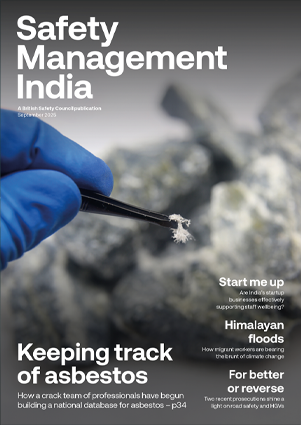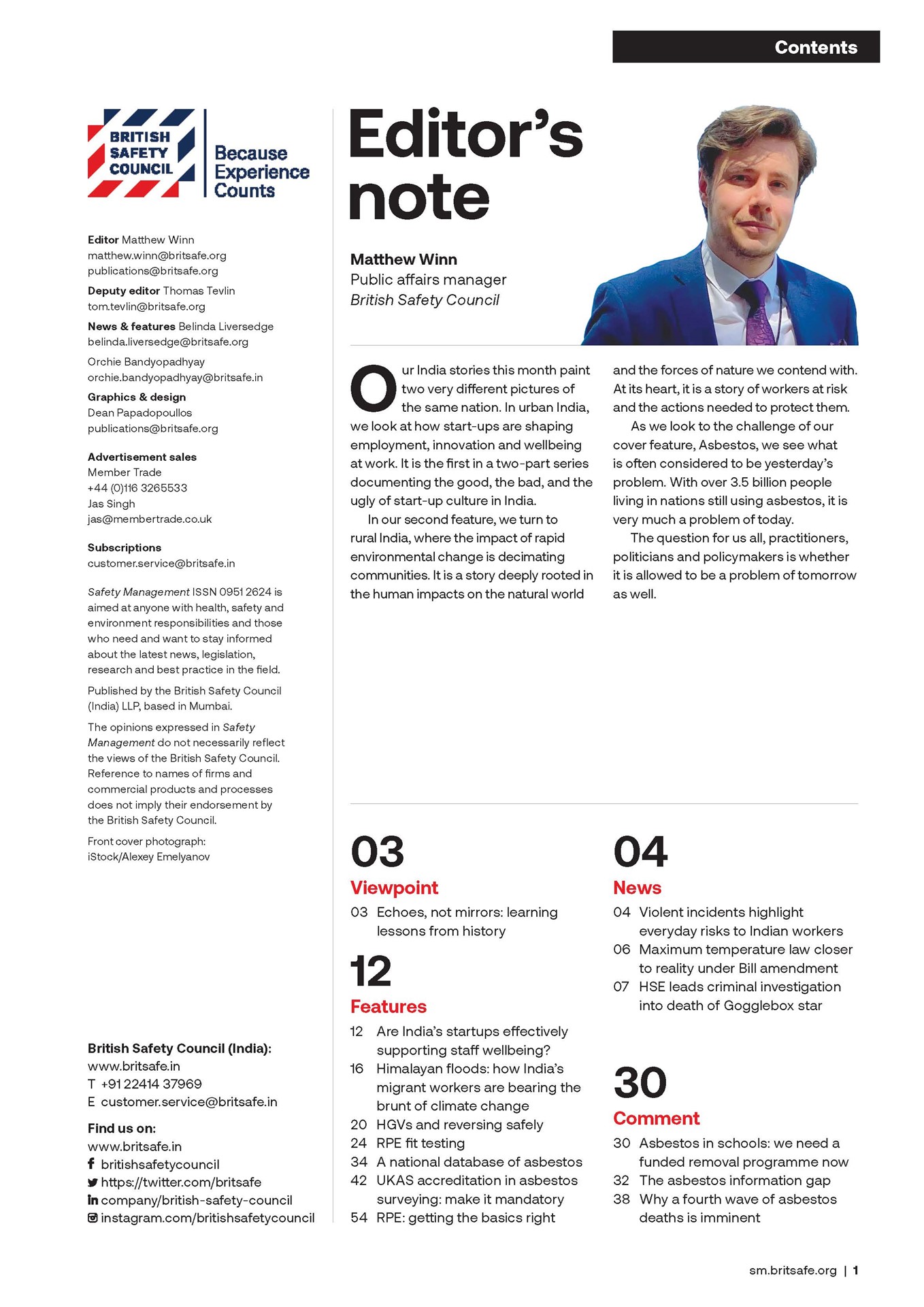Drones are often used to avoid the need for humans to work at height, but they can also be used in certain dangerous confined spaces, such as silos, sewers and tanks, reducing the risk to workers.
Opinion
Drones: flying high or greater depths?
Drones, Unmanned Aerial Vehicles (UAVs), Remotely Piloted Aircraft System (RPAS)… whatever you wish to call them they have been an increasing presence in life since becoming commercially available in the 2010s with many people worldwide taking up drone flying as a means of enjoyment.
Drones, however, are also powerful tools with many varying applications being used by professionals in the world of work. From surveying of agricultural land and rail lines to remote delivery of parcels by major logistics companies; to assisting in emergency rescue situations and even being fitted with attachments like pressure washers to clean difficult-to-reach areas; the application uses are wide.
 If used properly, drones can be powerful tools to help reduce time and cost and improve safety. Photograph: iStock
If used properly, drones can be powerful tools to help reduce time and cost and improve safety. Photograph: iStock
Arguably, the main strength of drones is as an inspection tool allowing for high quality video and images – often in real time – of hard-to-reach or high-risk areas, such as chimney stacks, roofs, pipework, ducting and other at height assets where the risk of a fall could result in fatal injury if a worker was required to carry them out in person.
Recognising this, many organisations are now engaging drone service providers or setting up internal programmes to help assist in this area to reduce the number of people working at height. However, there is one lesser considered area where drones can make a huge impact and that is in confined spaces.
The problem
Confined spaces pose a risk to those working in them globally and can be extremely hazardous. The U.S. Bureau of Labor Statistics reported that 1,030 fatalities occurred between 2011 and 2018 involving confined spaces so if we can do something to help reduce the number of incidents involving confined spaces we should.
The hazards presented by confined spaces can vary greatly depending on the type of confined environment and the industry activities that need to be carried out, among other factors. For example, a sewer system with the potential for free-flowing water would pose a different hazard to a boiler at a gas power station where heat and atmospheric hazards could be present.
In the UK there is specific legislation in the form of the Confined Space at Work Regulations 19972 designed to help control the safety risks from work in these environments as long as they meet the criteria of a confined space.
How can drones help?
When planning work in confined spaces the duty holder must apply the hierarchy of control and where possible avoid the need for workers to enter a confined space. In fact, one of the key duties of the Confined Space Regulations is Regulation 4 (1) which states: “No person at work shall enter a confined space to carry out work for any purpose unless it is not reasonably practicable to achieve that purpose without such entry.”
To this end drones can and are being used to carry out some work activities inside confined spaces (mainly inspection activities), reducing the need for human entry. Utility companies use drones to help inspect and map sewers and culverts.
Organisations in industrial sectors, like manufacturing and power generation, use drones to inspect silos, vessels, boilers etc, to identify defects which can help speed up repairs through targeted interventions.
The nuclear industry is a great advocate of the use of remotely operated vehicles, including drones, to inspect hazardous environments, such as radioactive and confined spaces. Indeed, the Nuclear Decommissioning Authority (NDA) in the UK has issued a ‘Grand Challenge’ of moving humans away from harm by adopting autonomous systems, sensors and robotics with many unique and leading-edge applications being conducted.3 For example, the Sellafield nuclear site, in the northwest of England, adapted a mini drone with a 3D printed bracket attachment to take a swab in an enclosed space 15m below floor level through a 150mm hole.
There is also a financial argument to be made because drones can reduce inspection time and remove other costs, such as the need for scaffolding, from the work activity. Both of these are significant motivating factors for many key decision makers.
The drones
When picturing a drone most people will imagine the standard quadcopter design, essentially a rectangular piece of plastic with a rotor in each corner like the DJI Mavic series of drones. Although it is possible to adapt these to operate in confined spaces they are not specifically designed to operate in these environments as the confined space itself can interfere with satellite positioning which helps stabilise drone flight. Also, as the rotor blades are exposed, contact with objects can cause damage to the blades, causing the drone to crash.
 Neil Blacklock: "Although they are powerful tools drones are not a silver bullet for removing the need to enter confined spaces."
Neil Blacklock: "Although they are powerful tools drones are not a silver bullet for removing the need to enter confined spaces."
There are alternatives though with the market leader being the Flyability Elios series (currently in its third iteration with the Elios 3). These drones are designed to carry out flights in internal environments and look markedly different from most drones as the main drone body is surrounded by a spherical cage to protect from impacts with objects when conducting a flight.
The Elios series has the standard capabilities of most drones – being able to capture high resolution images and video. However, it also has some additional features which can greatly help internal inspection – such as Lidar sensors to digitally map the internal environment and allow for the creation of 3D photogrammetric models which can be inspected by engineers from their office.
Limitations and challenges
Although they are powerful tools drones are not a silver bullet for removing the need to enter confined spaces. Drones cannot operate in environments where there are explosive atmospheres as they are generally not intrinsically safe, or ATEX or Ex rated; have limitations surrounding battery life (many drones have a maximum flight time of 25–40 mins on a single battery); and can only be used in certain applications, such as visual inspection, surveying etc, as they cannot operate tools to carry out repair work.
The cost of higher end, specialist drones can also be prohibitive for a lot of organisations, reaching into the tens of thousands of pounds.
Users do not need a specific licence to fly a drone internally inside a building or confined space; however, drones flying outside (including take-off and landing) are subject to the Civil Aviation Authority (CAA) rules which govern UK airspace. These regulate drone flight – requiring registration with the CAA, operational authorisation and technical training designed to ensure the drone’s correct and safe operation.
Drone operations also pose a risk of a falling object in the event of battery, rotor or other failure. Drone operations must be risk assessed and procedures put in place to reduce the impact of these potential events. Competence is a key factor in completing drone operations safely and smoothly, and regular flight time and experience are required to achieve the appropriate level.
An internal drone programme for a business is a significant undertaking with money and time implications. However, dedicated drone service providers can be used as an alternative to internal programmes, bringing the benefits of immediate competence and lower costs.
Final thoughts
The use of drones in confined spaces comes with some limitations. However, the argument can be made that any organisation with sufficient resource and technical competence to use drones in specific circumstances to avoid the need for human entry must do so as per Regulation 4(1) of the Confined Space Regulations 1997.
The current available options for use are predominantly in the higher risk, higher hazard industries which have the resource, technical competence and specific circumstances to carry out these activities. Ideally, technological advancements will make drones cheaper, expanding their possible uses and making drones even easier to use. This, coupled with more awareness of the potential for drones to reduce the need to work in hazardous environments – such as work at height, confined spaces, spaces with hazardous atmospheres or radiation – means the application uses will hopefully expand to more sectors and organisations.
If used properly, drones can be powerful tools to help reduce time and cost and improve safety. Drones should always be considered in the planning stage of works and if reasonably practicable be integrated into the appropriate tasks to avoid the need for humans to enter or be faced with hazardous environments.
Neil Blacklock is SHEQ manager for Rainham Industrial Services. He has an MSc in Safety, Health and Environmental Management, is a Chartered Member of IOSH (CMIOSH) and is vice-chair of the IOSH hazardous industries group committee. Connect with him at: linkedin.com/in/neilblacklock



